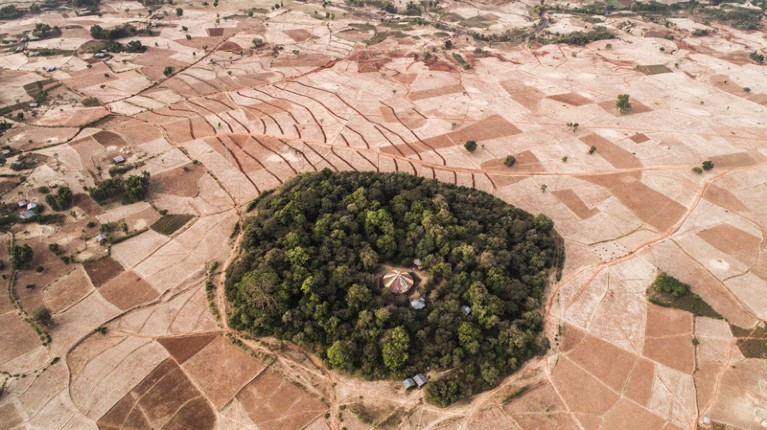
Forest land surrounding Ethiopia’s churches are important islands of biodiversity. The government has pledged to restore 15 million hectares of degraded and deforested land by 2030.Credit: Kieran Dodds/Panos
The Great Green Wall of Africa, a plan to restore a 7,000-kilometre-long stretch of degraded land from Senegal in West Africa to Djibouti in the east, is a bold and ambitious idea intended to help combat drought and desertification, which currently affect around 45% of Africa’s land area. Proposed 13 years ago by two of the continent’s elder statesmen, Nigeria’s then president Olusegun Obasanjo and Senegal’s former president Abdoulaye Wade, it is even more important now, given the threat from climate change and the reliance of the continent’s people on agriculture for their livelihoods.
But, so far, the project has struggled to reach key goals. Less than one-fifth of the designated land area has been restored or rehabilitated. The African Union’s top decision makers don’t see the green wall as a priority, and inter-national donors seem reluctant to commit further funding. Researchers, governments and international agencies must work together better to rehabilitate this crucial scheme.
The project’s focus has widened from its founders’ vision because there are more ways to restore degraded land than by reforestation, such as creating communal gardens and nature reserves. But the addition of these and other measures has made the green wall more complex. It has required different ministries in individual countries to work together. That is always difficult, but it becomes even more so when two further variables are added: the African Union and the international donor community. These and other observations are confirmed in an independent assessment of the project, commissioned by the project’s partners and published in September by the United Nations Convention to Combat Desertification (UNCCD).
The assessment report tries to look on the bright side. It says that 11 countries along the green wall have re-habilitated nearly 4 million hectares of land and created 350,000 jobs in the process. It also confirms that a broader group of 21 African countries is committed to restoring and rehabilitating 100 million hectares of land by 2030, creating 10 million green jobs. But it doesn’t sugar-coat the fact that governments and donors will need to find between US$3.6 billion and $4.3 billion every year for the next decade if the 100-million-hectare target is to be achieved. That will be a tall order — the report calls it a “quantum leap” — considering that the project raised around $2 billion in its first decade. But it is not impossible — and there are several key ways in which researchers can contribute.
The UNCCD report provides headline information on each country’s progress — such as the numbers of plants and seedlings produced; the area of land reforested; and the numbers of people trained and jobs created. Most of these data were provided by each country. The next step should be for independent researchers — for example, members of IPBES (the Intergovernmental Science–Policy Platform on Biodiversity and Ecosystem Services) — to assess these data and publish their own reviews, to help all sides have more confidence in the data and in the monitoring process.
Funding is always a challenge in such projects. But although it might seem feasible that the 55 member states of the African Union and their inter-national partners could raise the required amounts, nations have already committed funding to inter-national initiatives with similar goals to those of the green wall. African countries, for example, are signatories to the Aichi Bio-diversity Targets, which include a goal to reduce habitat loss and degradation. Countries have also signed up to the UN Sustainable Development Goals, which include a target of combating desertification and restoring degraded land and soil. And they are also members of the UNCCD, which has pledged to reach what it is calling “land degradation neutrality” by 2030.
The UNCCD report suggests a single trust fund could be the answer. That would work if countries and international agencies agree to pool their resources and create harmonized reporting requirements. Researchers could help here by developing a method for measuring whether countries are succeeding in meeting their green-wall goals, as well as providing a common accounting framework.
The need to restore and rehabilitate land is urgent. People in the affected countries are among the world’s poorest. The overwhelming majority earn their living from agriculture or livestock production. Climate change is projected to lift average temperatures by 3–6 °C by the end of the century, compared with a late-twentieth-century baseline. More extremes of weather are expected, and these, in turn, will reduce crop yields.
The green-wall project needs international agencies to cooperate better, it needs researchers to help, and it needs the present generation of the continent’s leaders to step up and take on a more visible role in championing it, just as its two founding presidents did.

 Read the paper: An unexpectedly large count of trees in the West African Sahara and Sahel
Read the paper: An unexpectedly large count of trees in the West African Sahara and Sahel
 How to plant a trillion trees
How to plant a trillion trees





